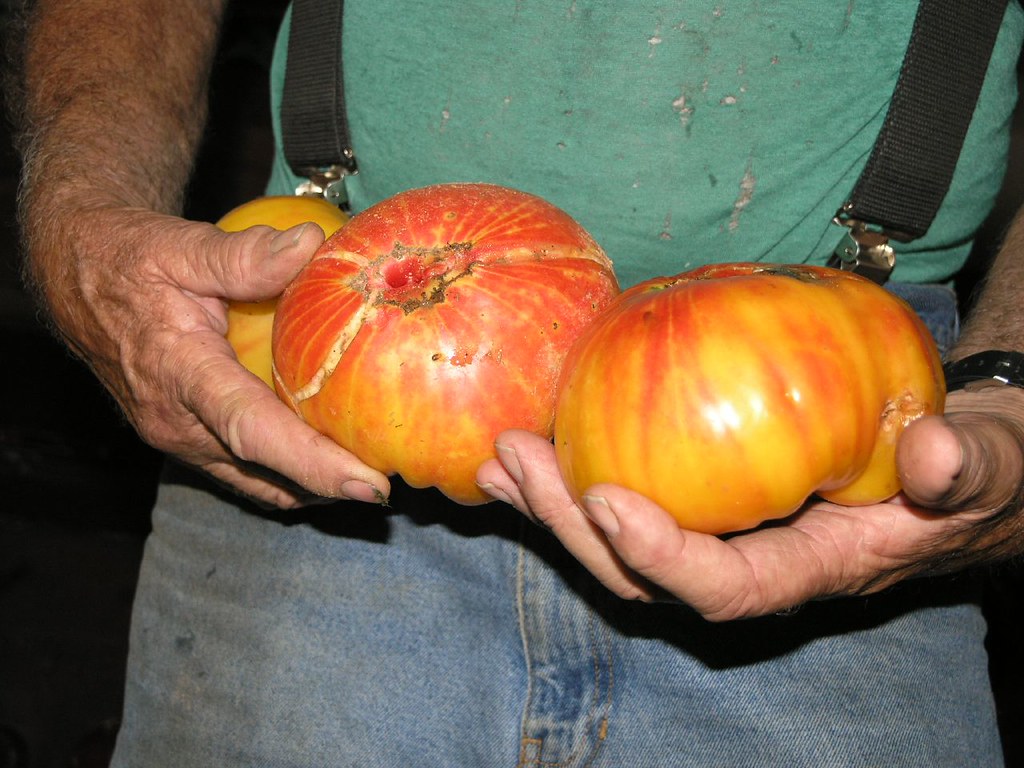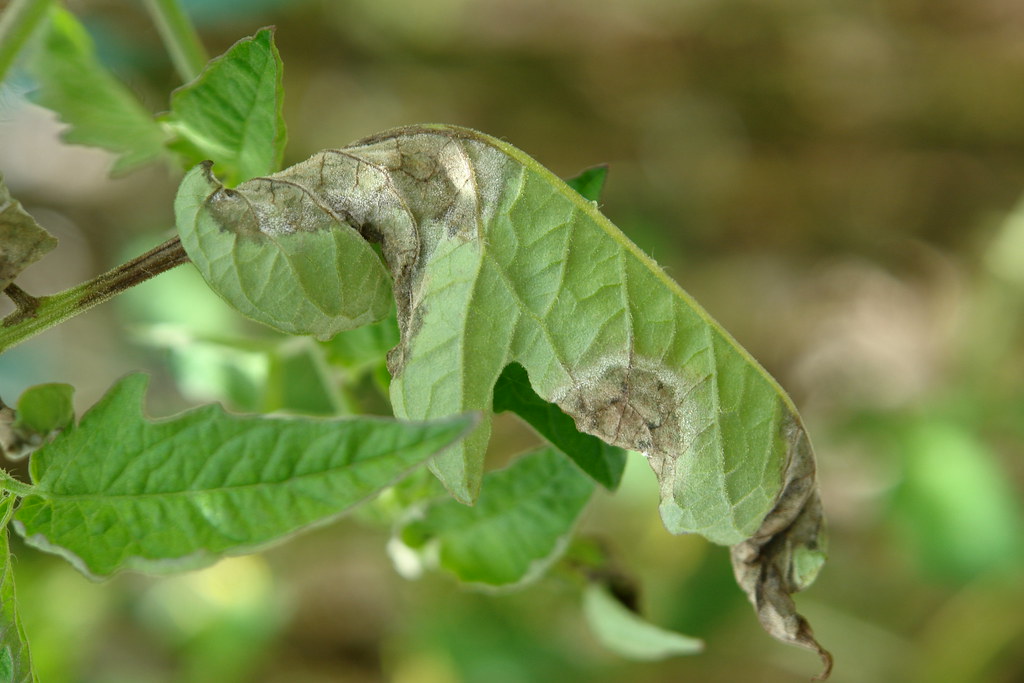Growing Tomatoes at Home
go.ncsu.edu/readext?789441
en Español / em Português
El inglés es el idioma de control de esta página. En la medida en que haya algún conflicto entre la traducción al inglés y la traducción, el inglés prevalece.
Al hacer clic en el enlace de traducción se activa un servicio de traducción gratuito para convertir la página al español. Al igual que con cualquier traducción por Internet, la conversión no es sensible al contexto y puede que no traduzca el texto en su significado original. NC State Extension no garantiza la exactitud del texto traducido. Por favor, tenga en cuenta que algunas aplicaciones y/o servicios pueden no funcionar como se espera cuando se traducen.
Português
Inglês é o idioma de controle desta página. Na medida que haja algum conflito entre o texto original em Inglês e a tradução, o Inglês prevalece.
Ao clicar no link de tradução, um serviço gratuito de tradução será ativado para converter a página para o Português. Como em qualquer tradução pela internet, a conversão não é sensivel ao contexto e pode não ocorrer a tradução para o significado orginal. O serviço de Extensão da Carolina do Norte (NC State Extension) não garante a exatidão do texto traduzido. Por favor, observe que algumas funções ou serviços podem não funcionar como esperado após a tradução.
English
English is the controlling language of this page. To the extent there is any conflict between the English text and the translation, English controls.
Clicking on the translation link activates a free translation service to convert the page to Spanish. As with any Internet translation, the conversion is not context-sensitive and may not translate the text to its original meaning. NC State Extension does not guarantee the accuracy of the translated text. Please note that some applications and/or services may not function as expected when translated.
Collapse ▲Tomatoes are not the easiest vegetable to grow, but with some guidelines and best gardening techniques you can improve your chances of producing that perfectly ripe, luscious tomato.
The first step is choosing the growth type. Tomatoes grow in two ways:
Indeterminate types are tall growing plants, normally 5 to 8 feet tall, producing a fruit cluster on the stems between every third leaf. Most home garden tomato varieties belong to this group. They produce a shoot or “sucker” at each leaf axil. These suckers, if left undisturbed, grow into larger stems and produce fruit, but it is advised to remove excess suckers. A general rule of thumb is if plants are spaced 3 feet apart, leave 3 stems per plant and remove all other suckers before they grow to 3 inches long.
Determinate types are shorter growing plants, normally 1 to 5 feet tall, producing a fruit cluster on stems between each leaf, and each stem terminates in a fruit cluster. ‘Roma’ is an example of a determinate tomato. If your goal is to can your tomatoes, you would want a determinate, so your tomato crop will mature all at once.
If you have never grown tomatoes, try cherry tomatoes first. They are the easiest to grow and are highly productive plants. My favorite cherry tomato is ‘Chocolate Cherry.’ It is an heirloom variety with golf ball-sized, deep-purple tomatoes and incredible flavor. I have been known to pop them in my mouth straight from the vine as I tend my other garden plants. I always have enough for my own use and to share with my neighbors. While this is an indeterminate tomato, I have also grown it successfully in a container, fruiting from summer through fall.
The next step would be to choose hybrid tomato types like ‘Whopper’ or ‘Better Boy’ that have been bred for better disease resistance. This year I am trying the Park’s Whopper VF1F2NT. The letters following the cultivar name indicate disease resistance. VF1F2NT means it is resistant to verticillium wilt (V), 2 strains of Fusarium wilt (F1F2), root-knot nematodes (N), and tobacco mosaic virus (T).
Lastly, but definitely not least in flavor, gardeners can choose heirloom varieties. The key with heirlooms is to choose ones that do well with our high summer heat, like ‘German Johnson’ or ‘Homestead’. My most successful heirloom last year was ‘Mr. Stripey’. It is a large beefsteak with red-yellow fruit. It is also resistant to late blight. Last year was not my best ‘Cherokee Purple’ tomato harvest, but it is one of the best tasting so I continue to plant it.

‘Mr. Stripey’ Mandie CC BY-NC_ND 2.0
Every successful plant needs the best soil available for a healthy root system. The best way to ensure this is to complete a soil test. Soil test kits are typically available at your local N.C. Cooperative Extension office and then sent to the North Carolina Department of Agriculture and Consumer Services (NCDA&CS) for analysis. If you haven’t soil tested your garden, be sure to do so as soon as possible and then every 3 years. Clay and sandy soils can be improved by working in 2 to 3 inches of compost into the top 6 to 9 inches of soil. Lime and fertilizer should be added according to soil test recommendations. By moderating soil pH, lime helps reduce conditions favorable for blossom end rot.If you choose to use a container, use as large of one as possible, with drainage holes and a well-drained potting media.
Tomato plants should be spaced approximately 3 feet apart. The planting hole should be deep enough to cover not only the roots of the plant, but when you are planting also remove some of the lower leaves by pinching them off and plant to cover the lower stem. Tomatoes are one of the few plants that prefer to be planted deeply.

Late Blight of Tomato (Plant Pests and Diseases – Public Domain)
A starter solution should be used at planting time to ensure proper fertilization during the early growth stages. To make a starter solution, mix 3 to 4 tablespoons of fertilizer (8-8-8) per gallon of water. Use no more than one cup of fertilizer solution per plant.
Tomato plants should be staked or caged at planting. Generally, staking produces larger tomatoes but less quantity than caging.
Side-dress tomato plants with 2 to 3 tablespoons per plant of 8-8-8 fertilizer after the plants have started to set fruit and 4 to 6 weeks thereafter throughout the growing season.
It is important to make sure the tomatoes receive sufficient water during the season, typically soaking your tomatoes 6 to 8 inches deep every 7 days. Consider mulching to conserve soil moisture.
What are the things you should be considering and watching out for as your tomatoes grow?
- Summer heat causes problems with ripening, fruit set, and flavor. Most tomatoes grow and produce best when daytime temperatures range from 70 to 80 degrees F, and night temperatures fall between 60 to 70 degrees F. Most of our summer temperatures cause plants to shed their blossoms without setting fruit. One way to help with this is to plant your tomatoes as early as possible. Be sure to check your area’s frost-free date.
- Always include a few disease-resistant varieties in your garden. Look for VFN on the plant label to symbolize resistance to verticillium, fusarium, and nematodes. You can also plant tomatoes in several locations instead of all together in one bed to prevent the spread of disease. Avoid planting tomatoes in the same location in your garden year after year. I manage this crop rotation by having 2 raised beds. One year I put tomatoes, peppers, and eggplants in Bed 1 (as all of these plants are related and get the same diseases), then the next summer I switch them to Bed 2. However, if space allows, we recommend following a 3-4 year rotation among different plant families to help break soilborne disease cycles. If you have had problems with tomato wilt diseases you may also want to consider container gardening.
- Another way to reduce your chance of disease is to remove all lower leaves that touch the soil. Many soil diseases are splashed onto the foliage by rain or watering. As the plants grow up, continue to remove lower leaves, keeping a buffer between the top of the soil and the lowest leaves. Plants can also be mulched to reduce soil splashing.
- When watering, water near the soil level to prevent getting the leaves wet. I put my hose end near the base of the plant and turn on my rain barrel to allow a long slow soak. You can also consider regularly applying a copper fungicide. Copper is an organic option for the control of many fungal and bacterial diseases.
- Blossom-end rot of tomatoes is a physiological disorder caused by a lack of calcium. This disorder results in the decay of tomato fruits on their blossom end. It is usually most severe following extremes in soil moisture (either too dry or too wet). To reduce blossom-end rot in tomatoes, be sure to lime, fertilize properly, mulch plants, irrigate when necessary, and spray a calcium solution. Note that calcium foliar feeding is only a stop-gap solution, and focus on cultural methods to address the underlying causes of blossom end rot.
The goal of this article is to set you up with the most successful methods to grow homegrown tomatoes. There is a wealth of tomato articles written by your local Extension agents online or consult the NC Extension Gardener Plant Toolbox, and the Extension Gardener Handbook.


